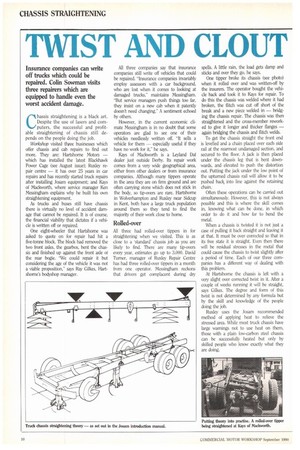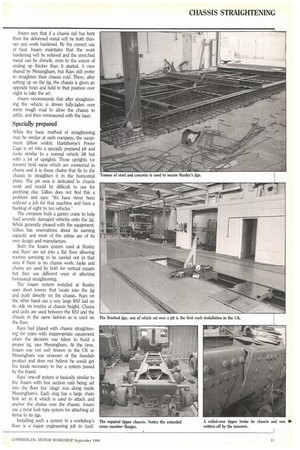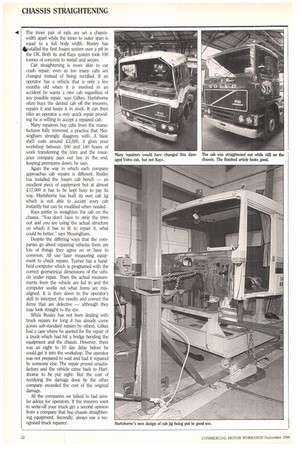TWIST AND CLOUT
Page 98

Page 99

Page 100

If you've noticed an error in this article please click here to report it so we can fix it.
Insurance companies can write off trucks which could be repaired. Colin Sowrnan visits three repairers which are equipped to handle even the worst accident damage.
Chassis straightening is a black art. Despite the use of lasers and computers, the successful and profitable straightening of chassis still depends on the people doing the job.
Workshop visited three businesses which offer chassis and cab repairs to find out more. They are: Hartshorne Motors — which has installed the latest Blackhawk Power Cage (see August issue); Ruxley repair centre — it has over 25 years in car repairs and has recently started truck repairs after installing Josarn equipment; and Kays of Mackworth, where service manager Ken Messingham explains why he built his own straightening equipment.
As trucks and buses still have chassis there is virtually no level of accident damage that cannot be repaired. It is of course, the financial viability that dictates if a vehicle is written off or repaired.
One eight-wheeler that Hartshorne was asked to quote on for repair had hit a five-tonne block. The block had removed the two front axles, the gearbox, bent the chassis and finished up against the front axle of the rear bogie. "We could repair it but considering the age of the vehicle it was not a viable proposition," says Ray Gilkes, Hartshorne's bodyshop manager. All three companies say that insurance companies still write off vehicles that could be repaired. "Insurance companies invariably employ assessors with a car background, who are lost when it comes to looking at damaged trucks," maintains Messingham. "But service managers push things too far, they insist on a new cab when it patently doesn't need changing." A sentiment echoed by others.
However, in the current economic climate Messingham is in no doubt that some operators are glad to see one of their vehicles needlessly written off. "It sells a vehicle for them — especially useful if they have no work for it," he says.
Kays of Mackworth is a Leyland Daf dealer just outside Derby. Its repair work comes from a very wide geographical area, either from other dealers or from insurance companies. Although many tippers operate in the area they are on firm ground and are often carrying stone which does not stick in the body, so tip-avers are rare. Hartshorne in Wolverhampton and Ruxley near Sidcup in Kent. both have a large truck population around them so they tend to find the majority of their work close to home.
Rolled-over
All three had rolled-over tippets in for straightening when we visited. This is as close to a 'standard' chassis job as you are likely to find. There are many tip-avers every year, estimates go up to 3.000. David Turner, manager of Rwdey Repair Centre has had three rolled-over tippers in a month from one operator. Messingham reckons that drivers get complacent during dry spells. A little rain, the load gets damp and sticks and over they go, he says.
One tipper broke its chassis (see photo) when it rolled over and was written-off by the insurers. The operator bought the vehicle back and took it to Kays for repair. To do this the chassis was welded where it had broken, the flitch was cut off short of the break and a new piece welded in — bridging the chassis repair. The chassis was then straightened and the cross-member reworked to give it longer and thicker flanges — again bridging the chassis and flitch welds.
To get the chassis straight the front end is levelled and a chain placed over each side rail at the rearmost undamaged section, and secured to the floor. A jack is then placed under the chassis leg that is bent downwards, and elevated to push the distortion out. Putting the jack under the low point of the upturned chassis rail will allow it to be pushed back into line against the retaining chain.
Often these operations can be carried out simultaneously. However, this is not always possible and this is where the skill comes in, knowing what can be done, in which order to do it and how far to bend the metal.
When a chassis is twisted it is not just a case of pulling it back straight and leaving it at that. It must be over corrected so that in its free state it is straight. Even then there will be residual stresses in the metal that could cause the chassis to twist slightly after a period of time. Each of our three companies has a different way of dealing with this problem.
At Hartshorne the chassis is left with a very slight over corrected twist in it. After a couple of weeks running it will be straight, says Gilkes. The degree and form of this twist is not determined by any formula but by the skill and knowledge of the people doing the job.
Ruxley uses the Josam recommended method of applying heat to relieve the stressed area. While most truck chassis have large warnings not to use heat on them, those with a plain low-carbon steel chassis can be successfully heated but only by skilled people who know exactly what they are doing. Josam says that if a chassis rail has bent then the deformed metal will be both thinner and work hardened. By the correct use of heat Josam maintains that the work hardening will be relieved and the stretched metal can be shrunk, even to the extent of ending up thicker than it started. A view shared by Messingham, but Kays still prefer to straighten their chassis cold. There, after setting up on the jig, the chassis is given an opposite twist and held in that position over night to take the set.
Josam recommends that after straightening the vehicle is driven fully-laden over some rough road to allow the chassis to settle, and then remeasured with the laser.
Specially prepared
While the basic method of straightening may be similar at each company, the equipment diffem widely. Hartshome's Power Cage is set into a specially prepared pit and looks similar to a normal vehicle lift but with a lot of uprights. Those uprights (or towers) hold rams which are connected to chains and it is those chains that fix to the chassis to straighten it in the horizontal plane. The pit area is dedicated to chassis work and would be difficult to use for anything else. Cakes does not find this a problem and says: "We have never been without a job for that machine and have a backlog of eight to ten vehicles."
The company built a gantry crane to help load severely damaged vehicles onto the jig. While generally pleased with the equipment, Gilkes has reservations about its earning capacity and most of the extras are of its own design and manufacture.
Both the Josam system used at Ruidey and Kays' are set into a flat floor allowing routine servicing to be carried out in that area if there is no chassis work. Jacks and chains are used by both for vertical repairs but they use different ways of affecting horizontal straightening.
The Josam system installed at Ru:dey uses short towers that locate into the jig and push directly on the chassis. Kays on the other hand use a very large RSJ laid on its side on trestles at chassis height. Chains and jacks are used between the RSJ and the chassis in the same fashion as is used on the floor.
Kays had played with chassis straightening for years with inappropriate equipment when the decision was taken to build a proper jig, says Messingham. At the time, Josam was not well known in the UK so Messingham was unaware of the Swedish product and does not believe he could get the funds necessary to buy a system passed by the board.
Kays' one-off system is basically similar to the Josam with box section rails being set into the floor but 'slugs' run along inside Messingham's. Each slug has a large chain link set in it which is used to attach and anchor the chains over the chassis. Josam use a twist lock type system for attaching all items to its jigs.
Installing such a system in a workshop's floor is a major engineering job in itself. The inner pair of rails are set a chassiswidth apart while the inner to outer span is equal to a full body width. Ruxley has Illinstalied the first Josam system over a pit in• the UK. Both its and Kays system took 100 tonnes of concrete to install and secure.
Cab straightening is more akin to car crash repair, even so too many cabs are changed instead of being rectified. If an operator has a vehicle that is only a few months old when it is involved in an accident he wants a new cab regardless of any possible repair, says Gilkes. Hartshorne often buys the dented cab off the insurers, repairs it and keeps it in stock. It can then offer an operator a very quick repair providing he is willing to accept a repaired cab.
Many repairers buy cabs from the manufacturer fully trimmed, a practice that Messingham strongly disagrees with. A basic shell costs around £3,500, it gives your workshop between 100 and 140 hours of work transferring the trim and the insurance company pays out less in the end, keeping premiums down, he says.
Again the way in which each company approaches cab repairs is different. Ruxley has installed the losam cab bench — an excellent piece of equipment but at almost £17,000 it has to be kept busy to pay its way. Hartshorne has built its own cab jig which is not able to accept every cab instantly but can be modified when needed.
Kays prefer to straighten the cab on the chassis. "You 'don't have to strip the trim out and you are using the actual structure on which it has to fit to repair it, what could be better," says Messingham.
Despite the differing ways that the companies go about repairing vehicles there are lots of things they agree on or have in common. All use laser measuring equipment to check repairs. Turner has a handheld computer which is programed with the correct geometrical dimensions of the vehicle under repair. Then the actual measurements from the vehicle are fed in and the computer works out what items are misaligned. It is then down to the operator's skill to interpret the results and correct the items that are defective — although they may look straight to the eye.
While Ruxley has not been dealing with truck repairs for long it has already come across sub-standard repairs by others. Gilkes had a case where he quoted for the repair of a truck which had hit a bridge bending the equipment and the chassis. However, there was an eight to 10 day delay before he could get it into the workshop, The operator was not prepared to wait and had it repaired by someone else. The repair proved unsatisfactory and the vehicle came back to Hartshorne to be put right. But the cost of rectifying the damage done by the other company exceeded the cost of the original damage.
All the companies we talked to had similar advice for operators. If the insurers want to write-off your truck get a second opinion from a company that has chassis straightening equipment. Secondly, always use a recognised truck repairer.




























































































































